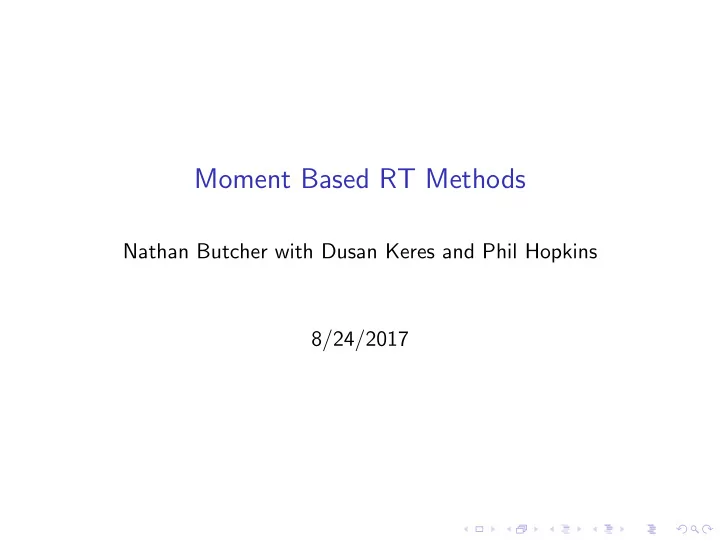

Moment Based RT Methods Nathan Butcher with Dusan Keres and Phil Hopkins 8/24/2017
Radiative Transfer ◮ Two closure methods implemented, OTVET and M1. ◮ Chemistry models that assume an equilibrium chemical state or allow for nonequilibrium evolution. ◮ Can track multiple energies of ionizing radiation. ◮ Check correctness on suite of tests outlined in Iliev, et al. 2006 (static) and Iliev, et al. 2009 (with hydro).
Test One ◮ Monochromatic 13.6 eV radiation, 10 48 photons per second. ◮ Gas is fixed at 10 4 K, no photoheating or any other cooling physics. ◮ Final radius of ionization, called the Str¨ omgren radius, has an analytic calculation. ◮ Both methods underpredict final Str¨ omgren radius but results are consistent with other codes (Iliev, et al. 2006).
Test One
Test Two ◮ Source spectrum is a 10 5 K blackbody emitting 10 48 photons per second. ◮ Effective single bin energy of 29.65 eV. ◮ Photoheating and cooling implemented, no hydro. ◮ Final radius is larger than Str¨ omgren sphere due to higher temperature (around 3 × 10 4 K compared to 1 × 10 4 K). ◮ RT in GIZMO is consistent with other codes in ionization front and temperature profiles.
Test Two
Test Two Figure: Temperature. Top: M1 Multifrequency. Bottom: Comparison in Iliev, et al. 2006
Test Two (a) One Bin (b) Four Bins Figure: Multiple energy bins captures preheating by high energy photons.
Test Three ◮ Shadowing by a dense clump, no hydro. ◮ Clump: n = 4 × 10 − 2 cm − 3 , T = 40 K ◮ Environment: n = 2 × 10 − 4 cm − 3 , T = 8000 K ◮ M1 produces shadow that lasts the entire test runtime. OTVET fails to produce a shadow, as expected.
Test Three (a) M1 (b) OTVET Figure: Projection of Neutral Hydrogen Fraction at 2 Myr
Test Three (a) M1 (b) OTVET Figure: Projection of Neutral Hydrogen Fraction at 15 Myr
Test Four ◮ Static cosmological density field at z = 9. ◮ 16 sources in the 16 highest density halos, with source luminosity proportional to the density. ◮ Recreate provided grid ICs in GIZMO. Only grid-based codes ran this test in the comparison paper. ◮ This test completely failed until June due to the ionization front stalling at high densities. ◮ Consistent disagreement between M1 and OTVET in this test.
Test Four Figure: In comparison paper, neutral fraction of the four codes tested ranged between 10% and 30%
Test Five ◮ Same as Test Two, but with live hydro. ◮ Reproduce ionization front position and gas outflow well when compared to comparison paper. ◮ Only tested with M1 so far.
Test Five
Test Five Figure: Number Density. Top: M1 Multifrequency. Bottom: Comparison in Iliev, et al. 2009
Test Five Figure: Mach number. Top: M1 Multifrequency. Bottom: Comparison in Iliev, et al. 2009
Future Work ◮ Finish the last two tests in the Iliev suite. Ionization front expansion from a dense core into an isothermal sphere and the photoevaporation of a dense clump. ◮ Reproduce tests on radiation pressure vs. photoionization pressure around a stellar source. (Sales, et al. 2014) ◮ Simulate an interesting HII region, such as 30 Doradus in the LMC (Lopez, et al. 2011) ◮ Largest HII region in local group, with 2400 OB stars ◮ Complicated shape with substructure
Recommend
More recommend